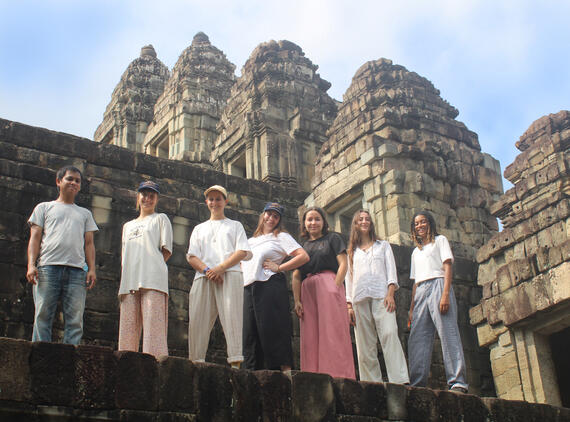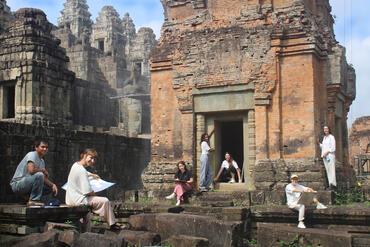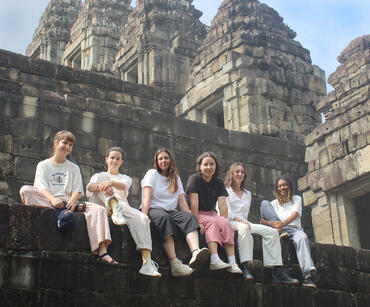Pleine Culture: An Introduction to Conservation at Angkor

In 2022, World Monuments Fund (WMF) welcomed a group of architecture students from France for a six-month internship with our team at Angkor Archaeological Park. Focusing on WMF’s work at the temple of Phnom Bakheng, the internship was an opportunity to foster international exchanges and bridge the gap between the fields of architecture, cultural heritage, and conservation. In this guest blog post, the six interns, known as Pleine Culture, reflect on their experience at Angkor and share their thoughts on the significance of heritage preservation.
***
Bonjour! We are six French architecture students, known as Pleine Culture. Having finished our bachelor’s degrees in architecture from Montpelier University, we decided to take a gap year before starting our master’s programs. It was essential for us to take a break from schooling and the structured academic way of learning architecture. This gap year was an opportunity to discover a different kind of architecture than the one we saw and studied in the classroom—to explore new ways of thinking about space, materials, and form.

Before traveling to Cambodia, we didn’t know much about Southeast Asia. But exploring the architectural traditions of places firsthand is a great way to meet people who know a lot about them. Through travel, our understanding of history takes on new importance and puts our lives into an expanded context.
Studying architecture and cultural heritage together during a gap year represents a significant undertaking. Cultural heritage preservation wasn’t taught or mentioned in our architecture understudies, and we never thought much about the challenges of preserving architecture older than a thousand years. But working at Angkor, we saw that conservation allows us to discover a different way of thinking about architecture, especially when it comes to the value of historic building materials, their traditional crafts, design concepts, and the thinking of people from the past.
At Phnom Bakheng, we are currently learned to conserve and restore monuments, and discovered the effort that is required. We are fortunate to have had the opportunity to spend time with WMF, especially against the backdrop of Angkor Archaeological Park, one of the world’s most important historical sites. Working with WMF’s documentation managers, we learned how integral recording existing conditions is to the conservation process. We practiced drawing a lot and went on-site every day to learn about the responsibilities of a documentalist in a project.

Although technology is changing the field of documentation, WMF staff member Som Sokea, with whom we worked, emphasized the need to continue manual processes; sketches, hand-measured drawings, and photography remain part of exemplary conservation. They also connect you to architecture in ways that many modern technologies do not - For instance, by making us think more about how buildings are put together. The notion of sharing and exchange being an important part of the WMF internship, when the opportunity arises, we also offered our skills and talents to aid the work of the local team.
We are grateful to WMF and Cambodian authorities for allowing Phnom Bakheng to become one of our exotic classrooms during this gap year. These memorable exchanges will make a meaningful difference in our lives and careers, and we hope it does the same for those at Angkor who helped us.
Penelope Puech, Eloise Ferro, Julie Renon, Sixtine Guillot, Solene Charbonnier, and Myriam Ly
World Monuments Fund’s work at Phnom Bakheng is supported by the U.S. Ambassadors Fund for Cultural Preservation and the U.S. Embassy in Phnom Penh, as well as by the Ralph E. Ogden Foundation and The Robert W. Wilson Charitable Trust, and an anonymous donor.
Stabilizing and Restoring Phnom Bakheng at Angkor, Cambodia
